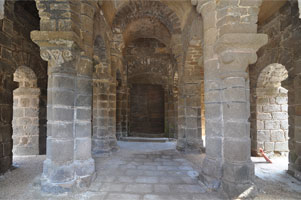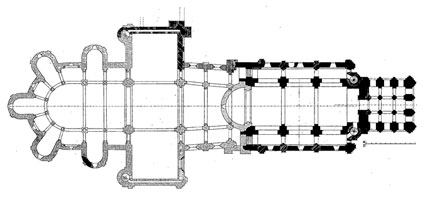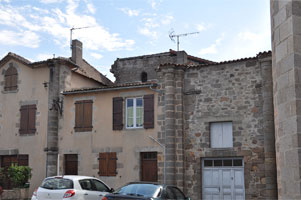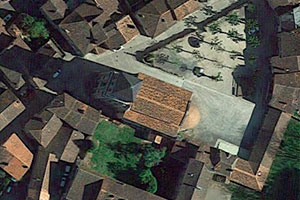The abbey of Lesterps traces its origins to the old church of Stirpis. According to tradition, around the year 975, Jourdain I of Chabanais established a community of canons there. However, reliable historical records only appear somewhat later. Around 1030, Gautier arrived from the canonical community of Le Dorat (Haute-Vienne) and introduced the Rule of Saint Augustine.
Around 1040, Jourdain II, the founder’s son, disagreed with Abbot Gautier and took advantage of his absence — as Gautier was possibly on pilgrimage to the Holy Land — to seize the monastery. In retaliation, Adalbert II, Count of La Marche, attacked the site, resulting in its destruction and the death of many canons. After receiving papal forgiveness, those responsible for the disaster undertook the reconstruction and endowment of the church. In 1070, Gautier himself was able to consecrate the new church, which was blessed in 1091. Gautier is said to have died that same year, 1070, and was buried in the church, where he was venerated as a saint.
Lesterps experienced a period of prosperity and was involved in the foundation or reform of other canonical houses, such as Notre-Dame de Celles (1095) and Saint-Pierre d’Airvault (1096), both in Deux-Sèvres, as well as Saint-Émilion (Gironde) around 1110. From 1110 onward, under Abbot Ramnulfe, the church was significantly expanded with the addition of a transept and a chevet with an ambulatory and radiating chapels.
In 1567, during the Wars of Religion, the monastery was attacked, looted, and burned, leaving it in ruins. Restoration was led by Abbot Charles-François de La Vieuville (1657–1676), who also facilitated its affiliation with the Congregation of Sainte-Geneviève. The canonical community was suppressed during the Revolution.
Parish worship resumed in 1803, although the building was in poor condition: it had already fallen out of use by 1738, and in the 19th century it deteriorated further. The entire chevet, transept, and part of the nave were lost. Today, in general, only the three bays of the original naves from Gautier’s time remain: a broad central nave flanked by very narrow side aisles. The current chevet is a modern reconstruction. The most notable feature of the site is the massive bell tower, also from the original period, which rises above a porch.
- ANDRAULT-SCHMITT, Claude (1991). Les premiers clochers-porches limousins (Êvaux, Lesterps, Limoges) et leur filiation au XIIe s. Cahiers de civilisation médiévale, núm. 135-136
- ANDRAULT-SCHMITT, Claude (1999). Lesterps, église Saint-Pierre. Congrès archéologique de France, 153 ss. Société française d'archéologie
- AUBERT, R. (2015). Dictionnaire d'histoire et de géographie ecclésiastiques. Vol. 31. París: Letouzey et Ané
- BEAUNIER, Dom (1912). Abbayes et prieurés de l'ancienne France. Vol. 5: Bourges. Abbaye de Ligugé
- COURCEL, Valentin de (1913). L'eglise de Lesterps. Congrès archéologique de France, 79 ss. Angoulême. Société française d'archéologie
- DEYRES, Marcel (1975). L’Abbatiale Saint-Pierre de Lesterps au XIe Siècle. Mémoires de la Société Archéologique et Historique de la Charente
- SAINT-MAUR, Congregació de (1720). Gallia Christiana in provincias ecclesiasticas distributa. Vol. 2. París: Typographia Regia
- VIOLLET-LE-DUC, Eugène (1875). Dictionnaire raisonné de l’architecture française du XIe au XVIe siècle. Vol. 3. París: A. Morel











